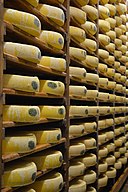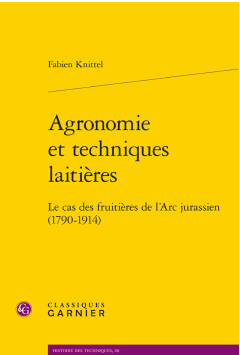– spontaneous skimming and skimmed milk machines.


[AIMA member Fabien Knittel has proposed a brief article as a follow-up to publication of his books Agronomie et techniques laitières, Le cas des fruitières de l’Arc jurassien, 1790-1914 (Agronomy and dairy techniques, traditional mountain cheese-making in the Jura) and La Fabrique du lait. Europe occidentale (Moyen Âge-XXe siècle), the second of which came out in February 2023. -ed.]
Spontaneous skimming was the traditional method. It lasted about twenty-four hours at least, until the cream came to the surface. This long period of time favoured the start of fermentation and the cream collected was often already sour. In the province of Holstein, spontaneous skimming was carried out without cooling the milk after milking and by pouring it into shallow pans on the floor. The cream was then scooped with oval, slightly hollowed spoons with a handle bent twice at right angles, called Schwartz spoons. It was then decanted into barrels before being churned.
Centrifugal skimming was faster than spontaneous skimming. Centrifugal skimmers, used mainly for butter production in industrial dairies, were emblematic of the industrialisation process of milk production in Western Europe. The technical operating principles of these centrifugal skimmers were due to Wilhelm Lefeldt (1836-1913) and Gustaf De Laval (1845-1913).
The centrifugal force separates two bodies of different densities: fat on one side, skimmed milk on the other. Louis de Mastaing (1830-1874), in France, at the beginning of the 1870s, studied these issues of centrifugal force. But Swedish engineer Carl Gustaf Patrik De Laval developed the first centrifugal skimmer for industrial use. As early as 1878, he patented the centrifugal skimmer which he developed from the Lefeldt process. It was a machine that separated the milk from the cream by rapidly rotating the container, creating a centrifugal force. Two pipes connected to the container allowed the cream to be discharged on one side and the skimmed milk on the other after skimming. In the Lefeldt process, the milk container is rotated at 1,200 revolutions per minute for 45 minutes. It became possible to make butter by turbining the whey. From the 1870s onwards, this by-product, which was mainly used as feed for calves and pigs, was valorised thanks to these new skimming techniques.
De Laval was awarded the Wallmark Prize by the Royal Swedish Academy of Sciences. In 1883, De Laval founded a skimmer manufacturing company with Oskar Lamm (1848-1930), called “AB Separator”. In 1888, in Munich, Clemens de Bechtolsheim (1852-1930) developed a steam-powered milk skimmer which, thanks to a regulator, allows the milk to be skimmed completely and continuously. This system was called Alfa and was soon combined with the Laval skimmer. The company, with this new model called “Baby Alfa”, later became “Alfa-Laval”. The Laval skimmer was soon found on many farms in Sweden by the end of the 19th century.
After 1878 and the introduction of centrifugal skimmers in France, their diffusion in Brittany was rapid and massive. According to the 1929 agricultural survey, there were just over 130,000 centrifugal skimmers in this region, i.e. almost 20% of the machines in use that year in France.
There were different types of bowls for centrifugal skimmers. In Belgium, the so-called “suspended bowl” process was developed by Jules Melotte (1858-1919). In the hanging bowl device, the milk container was held by a vertical rod to the drive shaft, hence the term hanging. This distancing of the bowl from the drive mechanism limited friction, allowing maximum use of the driving force to make skimming even more efficient.
In the end, the history of centrifugal skimmers in the second half of the 19th century illustrates an important moment in the process of industrialisation of the countryside in Western Europe.
Author: Fabien KNITTEL, Université de Bourgogne-Franche-Comté (UFC)/ Centre Lucien Febvre et MSHE-Ledoux, CNRS UAR 3124 fabien.knittel@univ-fcomte.fr
